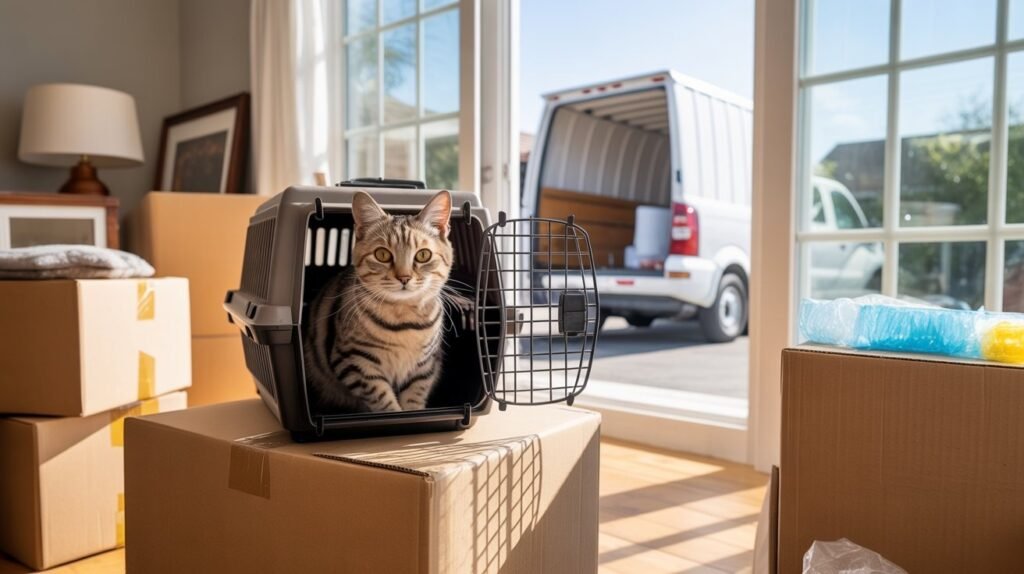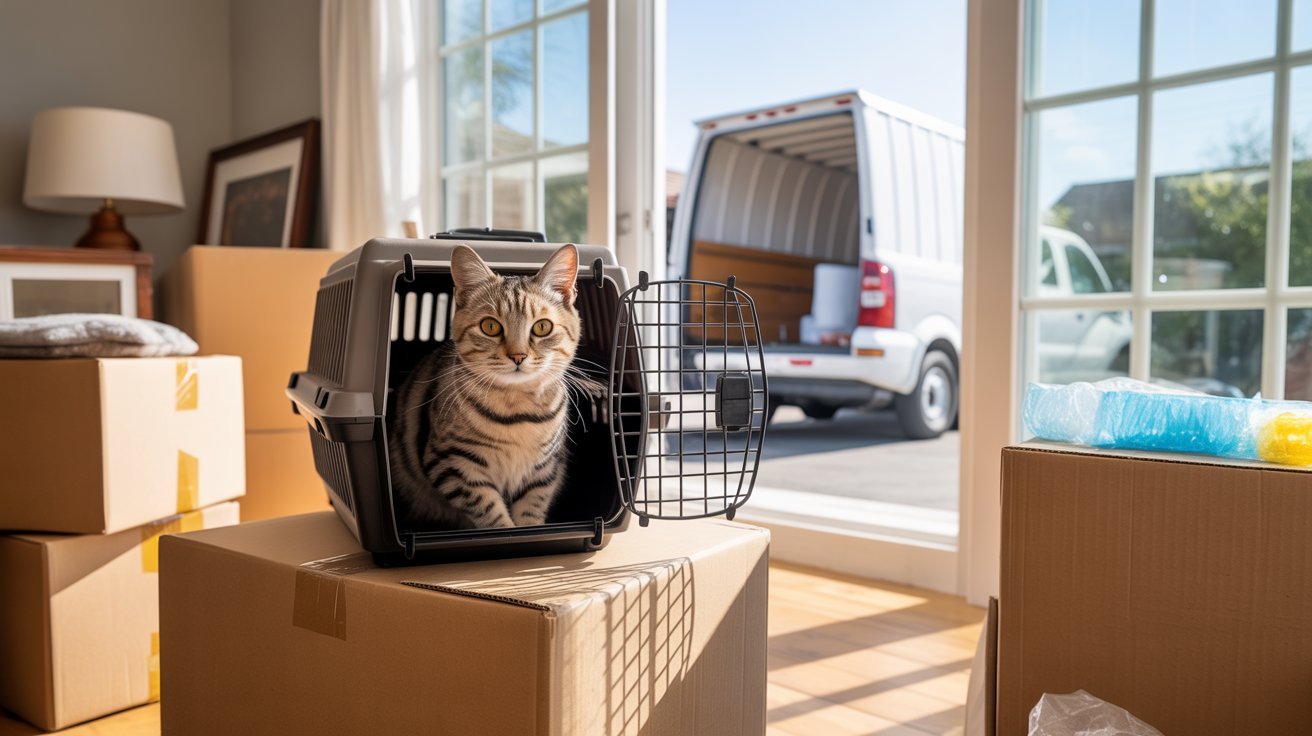Move an Older or Senior Cat Across the Country can feel like an emotional and logistical challenge. Senior cats have special needs they may be more sensitive to noise, temperature changes, and disruptions in their routines. Whether you’re relocating for work, family, or lifestyle changes, ensuring your older cat’s comfort and safety should be a top priority.
At Chamomile Go, we understand that your senior feline isn’t just a pet they’re family. With the right planning, gentle care, and proper preparation, you can safely move even the most delicate senior cat to a new home without overwhelming them. This guide will help you learn exactly how to move an older or senior cat across the country smoothly and with as little stress as possible.
1. Understanding Your Senior Cat’s Needs

Older cats often experience age-related changes such as arthritis, vision or hearing loss, and reduced immune function. These physical changes make senior cat travel more complex than moving with a younger feline. Before you start planning, take note of:
- Any existing health conditions (like kidney disease or arthritis).
- Current medications and special dietary needs.
- Stress tolerance how your cat reacts to change or travel.
Older cats may not handle long car rides, new environments, or loud sounds well. That’s why creating a move plan tailored to their comfort is essential for cat health and safety during travel.
Chamomile Go always recommends starting preparations at least a few weeks before the move. This gives your cat time to adapt to the idea of travel and reduces anxiety during the actual journey.
2. Schedule a Vet Checkup Before Traveling
Before you start packing, schedule a full veterinary exam for your senior cat. Inform your vet that you’re moving older cats across state or country lines.
Your vet can help with:
- Ensuring vaccinations are up to date.
- Checking for mobility issues or heart concerns.
- Reviewing medications and ensuring you have enough for the trip.
- Discussing stress management options like calming sprays or mild sedatives.
If you’re wondering how to move cats across country safely, the first step is always ensuring your cat’s health is stable enough for long-distance travel.
Ask your vet for a Certificate of Health, as it’s often required by airlines or state authorities when transporting pets across state lines.
3. Choose the Best Travel Method for Your Senior Cat
When it comes to senior cat travel, you have two main transportation options by car or by air. The best choice depends on your cat’s health, temperament, and the distance.
By Car
- Ideal for cats that get anxious in unfamiliar environments.
- You can control temperature, breaks, and background noise.
- Allows frequent stops for hydration and medication.
By Plane
- Faster but can be more stressful for elderly pets.
- Choose direct flights to minimize layovers and handling.
- Consider airline-approved carriers with enough room for comfort.
If you decide on air travel, consult Chamomile Go for expert advice on arranging safe and comfortable pet transport. Our team often helps pet owners navigate logistics, from paperwork to the best carrier types for cat health and safety during travel.
4. Selecting the Right Carrier for Comfort and Safety
A sturdy and comfortable carrier is non-negotiable when moving older cats. Choose one that:
- Has soft, padded lining for joint support.
- Offers good ventilation and enough space to stretch slightly.
- Is easy to clean in case of accidents.
- Can be covered with a blanket to block excess light and noise.
Pro tip: Add familiar scents inside the carrier like a favorite blanket or toy to reduce stress. You can also spray the interior with pheromone-based calming sprays.
At Chamomile Go, we often recommend soft-sided carriers for short car rides and rigid carriers for flights to ensure maximum cat health and safety during travel.
5. Packing the Essentials for Your Senior Cat
Older cats have more predictable routines and may struggle with changes in food, litter, or feeding schedules. Keep their essentials within reach to make the journey comfortable:
- Medications – Pack extra doses just in case of delays.
- Food and water – Stick to their regular diet to avoid stomach upset.
- Portable litter box and bags – Familiar litter reduces anxiety.
- Blanket or pillow – Smells like home and helps calm your cat.
- First-aid kit – Include gauze, antiseptic wipes, and any prescribed ointments.
These essentials are especially important if you’re learning how to move cats across country with minimal stress and maximum comfort.
6. Maintain a Calm and Predictable Environment
Senior cats are sensitive to emotional energy. If you’re stressed, your cat will feel it too. During travel:
- Speak softly and avoid loud noises.
- Keep the car temperature moderate neither too hot nor too cold.
- Play soft music or white noise to drown out unsettling sounds.
- Avoid unnecessary handling during stops.
Keeping things calm and consistent helps reduce panic and confusion. At Chamomile Go, we often tell pet parents that the best tool for senior cat travel is your own calm, patient energy.
7. Monitor Health Closely During the Move
Older cats can experience fatigue or dehydration more easily during travel. Keep an eye out for warning signs like:
- Rapid breathing or excessive panting.
- Lethargy or refusal to eat/drink.
- Unusual vocalization or confusion.
- Difficulty standing or walking.
If any of these occur, stop and give your cat a break. In severe cases, visit the nearest vet. Remember, cat health and safety during travel should always take precedence over sticking to a schedule.
8. Helping Your Senior Cat Adjust After the Move
Once you’ve arrived, give your cat a quiet, confined space to decompress. Older cats can feel disoriented after long trips, especially when surrounded by unfamiliar smells and sounds.
Here’s how to help them settle in:
- Set up a “safe zone” with their litter box, food, and bed.
- Stick to the same feeding and medication schedule.
- Gradually introduce them to new rooms.
- Avoid loud visitors or other pets for the first few days.
At Chamomile Go, we recommend using pheromone diffusers or soft bedding from their old home during the adjustment period. Patience and stability go a long way when moving older cats into a new environment.
9. Consider Professional Help
If your cat has complex health needs or extreme anxiety, a professional pet relocation service like Chamomile Go can manage the logistics for you. Our team specializes in stress-free transportation, ensuring your elderly feline receives proper care and comfort throughout the journey.
Whether by air or ground, how to move cats across country safely often depends on experience and planning both of which professional services provide.
Final Thoughts
Relocating with an older cat might sound daunting, but with preparation and empathy, it’s entirely possible to move an older or senior cat across the country safely and comfortably. Focus on maintaining routines, using the right equipment, and prioritizing cat health and safety during travel.
At Chamomile Go, we treat every pet like our own with compassion, care, and expertise. If you’re planning a move and want to make it as stress-free as possible for your senior feline, don’t hesitate to contact us. We’ll help ensure your cat’s journey is safe, gentle, and full of comfort.
FAQs
1. Is it safe to sedate an older cat for long-distance travel?
It depends on your cat’s health. Always consult your vet before using any sedatives, as some medications may affect heart or kidney function in older cats.
2. How long can a senior cat travel in a carrier without breaks?
For car trips, plan breaks every 3–4 hours for hydration and litter use. Older cats may need more frequent stops due to age-related bladder or joint issues.
3. Should I fly or drive with my senior cat?
If your cat is healthy and used to short trips, flying may be faster. However, for anxious or fragile cats, car travel allows more control and less stress ideal for moving older cats safely.
